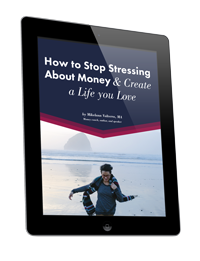As a money coach, I am sometimes asked about credit scores, and people are often surprised by my attitude. I feel that people worry about them too much. Credit scores (Your FICO score) tell potential creditors how good you are at borrowing money and paying it back. That’s it. So it is a bit of a game. Yes, it is good to have a nice credit score, so when you buy a house, you will receive a more favorable interest rate. But take a deep breath. You are not your credit score. It is simply a number. And like I said, it’s a number about borrowing. Don’t we want to get off the borrowing merry-go-round? I often wonder when I hear people bragging about their credit scores. Really? Are they really bragging about their ability to borrow money? Maybe they are bragging about their ability to play the credit game?
But let me de-mystify your credit score for a minute and then tell you how to easily obtain your score, and potentially raise it.
There are three credit bureaus in the United States that collect information on how you play the debt game: Trans Union, Experian and Equifax. They then use this information to create a FICO score for you. This is the number that many people are afraid of. Creditors look at this number to determine if they will lend you money and what interest rate they will extend to you. Equifax scores range from 280 to 850 (the other two are similar) and a score of 660-724 is average.
Your credit rating is based on your history of debt (late payments etc.), how much debt you have and how long you’ve had it. The type of debt you have and new debt also affects your score.
You can receive a free report once a year from all three bureaus. Here is where to go: www.annualcreditreport.com. It is very easy, believe it or not. Fill in the info and click which bureau you want your report from. And for less than 8 dollars, they will even tell you what your score is. (The report is free. You have to pay for that dang number.)
So do some deep breathing, make a cup of tea, give yourself an hour, and pull your 3 reports. Have your printer ready, so you can print them out.
Look at the reports, one at a time. Once you’ve looked at one, it will be less scary to look at the other two. (Unfortunately, they are not always identical. One credit bureau may have some extra info, or include inaccurate information that the other bureaus don’t show. So it is best to look at all three.) Looking at them on line is helpful, because the website will show you an easy to read summary. The actually reports sometimes look arcane.
If the information on your credit report is accurate, then it will stay. There is not a lot you can do about information that is true. If the information is not correct (for example they show a credit card you don’t have, or a tax lien that you don’t have) then you can dispute it. Doing this on line is fairly easy. Just click their “dispute” buttons. The burden of proof is on them. If you dispute something as not true, they have 30 days to either prove it is true, or they must take it off your report.
Things that are considered negative, such as late payments, charge offs etc., can only stay on your report for 7 years. Bankruptcies and tax liens stay for 10 years.
Breathe. This is only a number. Rarely do people have a perfect score or even close to a perfect score. And even if you have things that are not attractive, such as late payments, the farther back in time they are, the less it affects your credit score. Our numbers often tell a story. Many of us have been through hard times. You may see a period in your life when you really struggled. There are stories behind every report. You are not your credit score. You are not your report.The best thing you can do to “fix” your credit score is to dispute information that is inaccurate. Then, endeavor that from today forward, you will pay all bills on time. Control what you have control over.
Yes, many people need to lower their debt to income ratio. Paying down your debts will help. But many are stressed now. So focus on what you can focus on. Pay your bills on time and this will help tremendously.
Remember, this is only a number. You are a wonderful person who is growing and developing financially over time. You are NOT your credit score.
